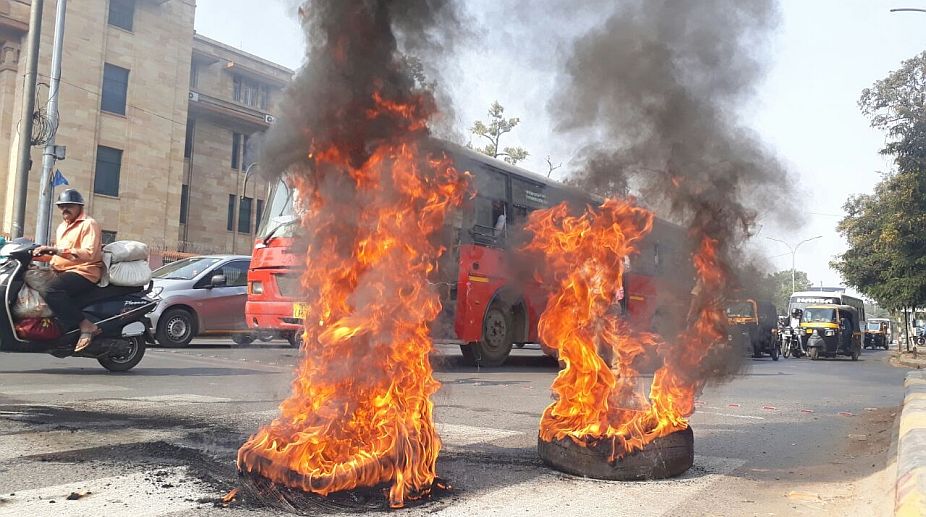AAP usurping rights of Dalits: Devender Yadav
He asserted that only the Congress works to protect the Constitution and the rights of Dalits.

Representational Image (Photo: IANS/File)
Bhim Rao Ambedkar (1891-1956) remarked in his famous tract Annihilation of Caste (1936) that Hindu society has evolved in the name of caste and not for the nation. Ambedkar’s remark was validated on the very first day of this year when there was a vicious opposition by a section of the Marathas against a large number of Dalits who had gathered in Koregaon. The event is celebrated every year as Victory Day by the Dalits against the upper castes. The year was the bicentennial year of the celebrations and was, therefore, a special day.
This event is marked on the basis of a historical narrative which began in 1800 when the Brahmin, King Peshwa II, lost the capital city of the empire, Pune, to the British. After his defeat he was forced to take refuge in Satara. In 1818, he had attempted to recapture Pune and led a massive army of 28,000 soldiers on a mission to regain the city. During this march, the King and his army met a small contingent of the British-led army. It numbered 800 soldiers, mainly manned by troops of the Mahar community at Koregaon who were moving towards Pune to reinforce the British Army. Peshwa II ordered 2000 army personnel to surround the British-led army and marched on.
There was a massive fight on 1 January, 1818, in which the army of 800 led by the British stopped the Peshwa army of 2000 to recapture and defeat them. They lost 300 to 400 lives while the Peshwas lost 500 to 600 people. After this huge loss, the Peshwas did not make any further attempt to enter Koregaon as they feared that more reinforcements might be brought in from Pune.
Advertisement
The problem is rooted in the fact that the Dalits celebrate this success not in the context of the nationalist perspective of an upsurge against a colonial power, but rather as a Mahar Dalit triumph of the lower untouchable caste against the higher caste. It is like a pilgrimage for the Dalits ever since Ambedkar visited the site in 1927. The bicentennial celebration was planned as a big show by the Dalits as an occasion to demonstrate the Dalit victory over the Marathas, which the Marathas resented and opposed leading to this huge confrontation between the two communities.
It has to be acknowledged that recent developments in Maharasthra are neither favourable for our democratic consolidation nor for building a cohesive social order that ensures elementary human rights to every single citizen. The question is that in Koregaon an Indian ruler lost to the British. Instead of mourning over it, why is that certain sections of Indians take pride in it. Why is it that thousands join to celebrate the war memorial in Koregaon every year?
The government’s response to commission a judicial enquiry and provide financial support to a family of a victin is grossly inadequate. The answer has to be sought in an unjust and cruel social order that has existed for thousands of years. Even after 70 years of Independence, the democratic praxis has failed to eliminate caste prejudices and grant equal treatment before the law to all. A sense of relative deprivation is a reflection that Maratha nationalism was not sustained by a larger Indian nationalism but relied on a resurgent Hinduism where the Dalits have no place.
It is a reflection of a wide cleavage that still exists between the upper castes and the lower castes in which even today upper castes are the real enemy of the Dalits and not the British colonial exploiters. It is a commentary on societal development that developments in the feudal and colonial past can evoke such a strong reaction even today.
In order to comprehend this phenomenon of a lack of national pride and to find a solution, it is imperative to examine the contradictions in our societal structure which have impeded our nationalistic consolidation. Ambedkar like Periyar (1879-1973) championed the primacy of social reform over political adventurism. With a narrow social base of our nationalist movement, Mahatma Gandhi did not accept the fact that the pernicious caste system was an obstacle to smooth political consolidation and advancement.
But Ambedkar rejected this thesis by emphasising that in India, unlike the West, property is not the source of power and authority. Instead, religion and caste influence one’s life. Ambedkar’s support for Dalit entry into temples was not an expression of faith in Hindu deities, but an essential pre-requisite for making them aware of their position in society and to facilitate their entry into a larger society, based on equality.
It is this mission to create equal and constitutional citizenship which has faltered grievously leading to the present impasse. Ambedkar observed that “democracy in India is only a top dressing on an Indian soil, which is essentially undemocratic”. He added that in the Indian condition, it was not enough to have only a formal political democracy.
It has to be based on liberty, equality and fraternity. It will have to be a unity of all three and a recognition that though the Constitution ensures political equality, our social and economic life is riddled with inequalities. Considering the US as an example, Ambedkar reminded us that it had no caste problem and in contrast India has enough of it.
This has impeded national consolidation, as it reflects “separation in social life”. He reminded us that “without fraternity, equality and liberty will be no deeper than coats of paint”. We have faltered in building a society of fraternity. To put in place an order in which every single Indian would participate and be proud of, is the challenge that we have to countenance and overcome.
(The writer is a retired Professor, Department of Political Science, University of Delhi)
Advertisement